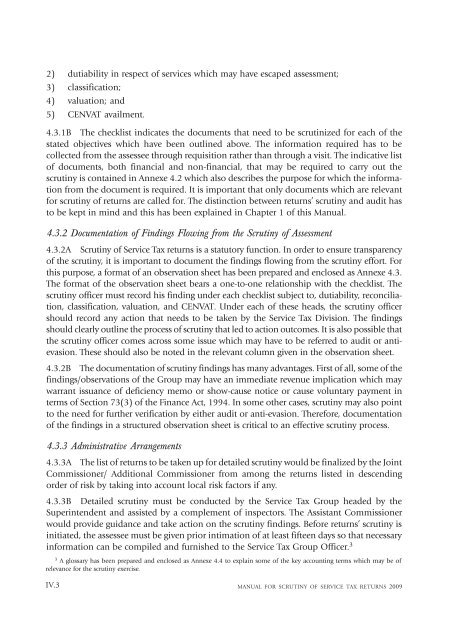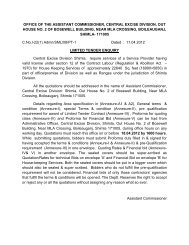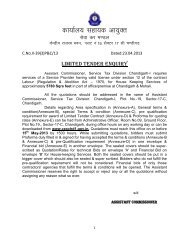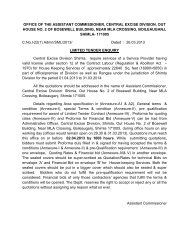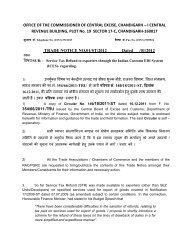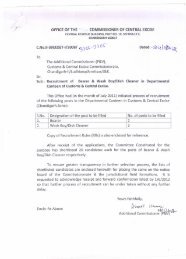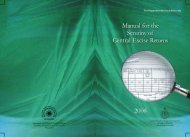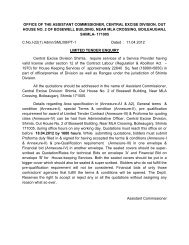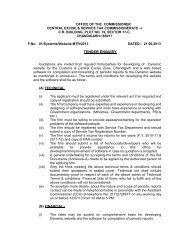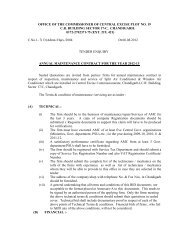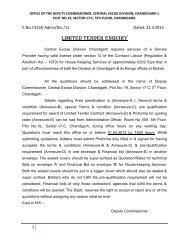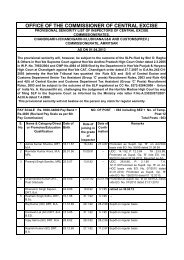Manual for Scrutiny of Service Tax Returns 2009 - Central Excise ...
Manual for Scrutiny of Service Tax Returns 2009 - Central Excise ...
Manual for Scrutiny of Service Tax Returns 2009 - Central Excise ...
- No tags were found...
Create successful ePaper yourself
Turn your PDF publications into a flip-book with our unique Google optimized e-Paper software.
2) dutiability in respect <strong>of</strong> services which may have escaped assessment;3) classification;4) valuation; and5) CENVAT availment.4.3.1B The checklist indicates the documents that need to be scrutinized <strong>for</strong> each <strong>of</strong> thestated objectives which have been outlined above. The in<strong>for</strong>mation required has to becollected from the assessee through requisition rather than through a visit. The indicative list<strong>of</strong> documents, both financial and non-financial, that may be required to carry out thescrutiny is contained in Annexe 4.2 which also describes the purpose <strong>for</strong> which the in<strong>for</strong>mationfrom the document is required. It is important that only documents which are relevant<strong>for</strong> scrutiny <strong>of</strong> returns are called <strong>for</strong>. The distinction between returns’ scrutiny and audit hasto be kept in mind and this has been explained in Chapter 1 <strong>of</strong> this <strong>Manual</strong>.4.3.2 Documentation <strong>of</strong> Findings Flowing from the <strong>Scrutiny</strong> <strong>of</strong> Assessment4.3.2A <strong>Scrutiny</strong> <strong>of</strong> <strong>Service</strong> <strong>Tax</strong> returns is a statutory function. In order to ensure transparency<strong>of</strong> the scrutiny, it is important to document the findings flowing from the scrutiny ef<strong>for</strong>t. Forthis purpose, a <strong>for</strong>mat <strong>of</strong> an observation sheet has been prepared and enclosed as Annexe 4.3.The <strong>for</strong>mat <strong>of</strong> the observation sheet bears a one-to-one relationship with the checklist. Thescrutiny <strong>of</strong>ficer must record his finding under each checklist subject to, dutiability, reconciliation,classification, valuation, and CENVAT. Under each <strong>of</strong> these heads, the scrutiny <strong>of</strong>ficershould record any action that needs to be taken by the <strong>Service</strong> <strong>Tax</strong> Division. The findingsshould clearly outline the process <strong>of</strong> scrutiny that led to action outcomes. It is also possible thatthe scrutiny <strong>of</strong>ficer comes across some issue which may have to be referred to audit or antievasion.These should also be noted in the relevant column given in the observation sheet.4.3.2B The documentation <strong>of</strong> scrutiny findings has many advantages. First <strong>of</strong> all, some <strong>of</strong> thefindings/observations <strong>of</strong> the Group may have an immediate revenue implication which maywarrant issuance <strong>of</strong> deficiency memo or show-cause notice or cause voluntary payment interms <strong>of</strong> Section 73(3) <strong>of</strong> the Finance Act, 1994. In some other cases, scrutiny may also pointto the need <strong>for</strong> further verification by either audit or anti-evasion. There<strong>for</strong>e, documentation<strong>of</strong> the findings in a structured observation sheet is critical to an effective scrutiny process.4.3.3 Administrative Arrangements4.3.3A The list <strong>of</strong> returns to be taken up <strong>for</strong> detailed scrutiny would be finalized by the JointCommissioner/ Additional Commissioner from among the returns listed in descendingorder <strong>of</strong> risk by taking into account local risk factors if any.4.3.3B Detailed scrutiny must be conducted by the <strong>Service</strong> <strong>Tax</strong> Group headed by theSuperintendent and assisted by a complement <strong>of</strong> inspectors. The Assistant Commissionerwould provide guidance and take action on the scrutiny findings. Be<strong>for</strong>e returns’ scrutiny isinitiated, the assessee must be given prior intimation <strong>of</strong> at least fifteen days so that necessaryin<strong>for</strong>mation can be compiled and furnished to the <strong>Service</strong> <strong>Tax</strong> Group Officer. 33A glossary has been prepared and enclosed as Annexe 4.4 to explain some <strong>of</strong> the key accounting terms which may be <strong>of</strong>relevance <strong>for</strong> the scrutiny exercise.IV.3MANUAL FOR SCRUTINY OF SERVICE TAX RETURNS <strong>2009</strong>


